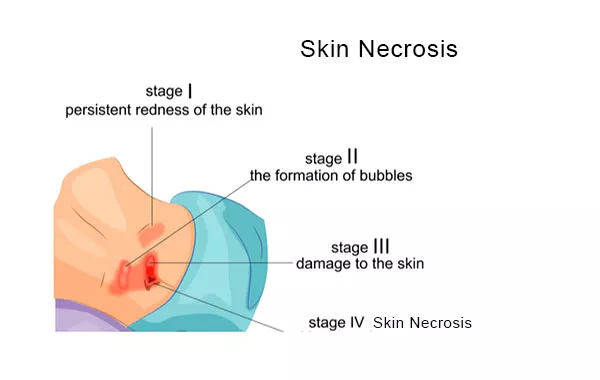
Skin Necrosis – a possible Post Surgery Complication for Plastic Surgery
Recovery after breast, tummy or face plastic surgery is usually straightforward. Recovery usually involves some bruising, swelling, and mild discomfort. However, if you are unlucky, you may experience a more serious complication, skin necrosis.
Following cosmetic surgery, due to disruption to the network of blood vessels supplying the skin surface, skin necrosis may occur. This is more likely to occur in smokers, diabetics or overweight patients. Post-op necrosis can be a scary ordeal, though it is manageable.
Here at Coco Ruby Plastic Surgery, we have a team of Australia’s leading plastic surgeons, they have experience in all aspects of surgery, including treating complications. Our surgeons are dedicated to giving you both premium care and premium treatment.
Below you can learn more about skin necrosis and what it looks like. We also explain some of the ways to treat it.
What Is Skin Necrosis?
Dermal or skin necrosis develops when there is a lack of blood supply to part of your skin. The lack of blood supply damages not only your skin but also the surrounding tissues. This compromise to the skin results in it turning black. Although rare, it can be a complication of breast lift, breast reduction, tummy tuck and/or facelift procedures.
Blood carries oxygen and nutrients necessary to maintain healthy tissue. When there is a disruption to your blood supply, not enough oxygen will reach your tissues.
Two other famous similar phenomena that resemble skin necrosis are:
Nipple necrosis
This is a rare complication of surgeries like Breast Reduction Mammaplasty. Despite the nipple always being connected during the procedure, the blood supply can be damaged when the surgeon removes excess skin, fat and breast tissue. This can result in Nipple Areola Necrosis, which presents as darkening to the nipple and/or areola complex.
Fat Necrosis
Blood supply to the fat at the operating site can also be reduced during a surgical procedure. This can occur after any operation, though is more commonly seen after free flap surgery, or fat grafting. It will typically present as firm lumps at the operated site during your recovery process.
When necrosis takes place, the affected tissues turn blue to black. It often has to be surgically removed. Removing the necrotic tissues allow for wound healing to take place and new skin to grow.
What Does Skin Necrosis Look Like?
In dermal necrosis, the affected area lacks adequate blood supply and nutrients. Eventually, the lack of oxygen will lead to the death of your tissues that may appear as:
- Dark blue, tan, or black tinge in the affected skin.
- Dry, leathery, and thick appearance that you usually see in scabs.
- Open wound on the affected skin.
When Do I See My Surgeon?
If you feel any of the abovementioned symptoms after breast surgery or tummy tuck, always inform your surgeon. An increase in pain, non-healing wounds, and/or fever should always prompt medical assessment.
Early treatment is essential to ensure proper treatment and the best possible cosmetic outcomes.
After Which Procedure Is Skin Necrosis Seen?
Skin necrosis is a rare complication of surgical procedures that may disrupt the vascular supply of your tissue. This is most commonly seen in;
- Breast Reduction or Mammoplasty: Reshaping the breast by removing excess fat, tissue, and skin.
- Lumpectomy: Surgical removal of cancerous tumours from the breast.
- Breast biopsy: Getting a sample of breast tissues for diagnosis.
- Mastectomy: Removal of the entire breast.
- Breast lifting or Mastopexy: Removal of excess breast skin and tightening the breast skin.
- Breast reconstruction surgery: Rebuilding the shape and appearance of the breast.
- Abdominoplasty or Tummy tuck surgery: Removal of excess skin to tighten the abdominal wall and muscles
- Nipple-sparing mastectomy: Removal of the breast tissue while preserving the nipple-areolar complex
- Face and/or neck lift:
What Causes Skin Necrosis?
Your skin is supplied by a complex network of small arteries that provide it with both oxygen and nutrients. They usually pass superficially in the subdermal layer of the skin. The disruption of the skin’s blood vessels for any reason can lead to a decrease in blood supply, known as ischaemia, and oxygen starvation, known as hypoxia.
Both skin and tissue ischaemia can happen in cosmetic surgery in 3 different ways;
- Direct blood vessel injury
- The dissection of subdermal and subcutaneous tissue during surgery can often lead to cutting the blood supply from the skin covering the operated area.
- This is especially true in surgeries involving significant tissue removal, like breast reduction or tummy tuck.
- When your body fails to compensate, the loss of blood supply leads to ischaemia and hypoxia.
- Blood vessel dysfunction
- Ischaemia can develop because of a blood clot or microvascular dysfunction, leading to a reduction in blood supply and tissue hypoxia.
- Tension
- Surgeries like tummy tuck and mastopexy (breast lift) involve pulling the tissue tight and suturing together.
- This leads to high wound tension, which can compress the blood vessels and block them, leading to decreased blood supply.
You should know that there’s no surgery without blood vessel injury. The moment your surgeon cuts your skin, your blood supply is compromised. Contributory blood vessels usually take over and re-route the blood supply to the injured area to prevent necrosis. However, in some patients, excessive dissection or the presence of risk factors (including smoking, diabetes etc.) may lead to irreparable ischaemia and tissue death.
Don’t tan your scars after surgery and definitely don’t smoke – smoking will kill you and botch your surgery results as it interferes with healing.
Risk Factors of Skin Necrosis
Certain factors can increase your chances of developing skin necrosis after surgery. You can manage these risks with the help of your surgeon’s expert care and advice.
Smoking
Smoking can increase the likelihood of many complications occurring including skin necrosis. Smokers have lower immunity, poorer wound healing, clogged blood vessels, and low blood oxygen levels. That’s a golden recipe for plastic surgery failure and skin necrosis.
Diabetes
The blood circulation in diabetic patients is usually less than ideal. Diabetes leads to the narrowing of blood vessels, which increases the risk of tissue ischaemia. Moreover, wounds in diabetics take longer to heal than average. This prolonged wound healing can increase the chances of both infection and skin necrosis.
Bacterial or Fungal Infections
Regardless of how thorough the sterility techniques in the Operating Room (OR) are, it is impossible to completely prevent all microbes from striving in some areas of the body, like the nipples. The nipples contain a rich bacterial flora. These might sometimes spill and cause post-op breast infection, and in rare cases skin necrosis.
Bacterial and fungal infections can compromise the blood supply to your skin and lead to skin necrosis after surgery. Whilst your surgeon will do everything they can to reduce the chance of infection, you can help reduce your bacterial load with thorough pre-operative body washes of your surgical area before coming to the hospital.
Obesity
Obesity can significantly increase your chances of developing skin necrosis. In obese patients, there is extra pressure on your arteries and a need for your body to work harder to pump blood. Aside from that, extra fat cells and tissues require extra blood and oxygen supply. Obesity puts your cells at a higher risk of not getting adequate nutrition and developing necrosis.
Steroid use
Steroids can lead to poor wound healing and can increase your risk of skin necrosis. If you are taking steroids, you must ensure you inform your Plastic Surgeon in your consultation so that they can formulate a specific plan for you.
Alcohol
Excessive alcohol consumption can lead to lower immunity and can reduce your body’s ability to heal itself after surgery.
Amount of Tissue removed during surgery
The more tissue you are having cut away, the higher the risk you’ll develop skin necrosis.
What Are The Complications Of Skin Necrosis?
If detected early, your surgeon can treat necrosis with a reduced chance of potential complications. If you do not undergo treatment in a timely manner, the reduced blood supply can be detrimental to the health of your tissue and your overall cosmetic result.
Dermal necrosis may lead to bacterial superinfection and the development of gangrene. Gangrene is the build-up of dead cells and tissues when the blood supply to a large area is cut off. The affected skin can turn a greenish-black colour and contain foul-smelling fluids.
The infection might extend further and pose a risk to your health. This is why we instruct our patients to seek help as soon as they suspect skin necrosis after any cosmetic surgery.
What Are The Treatment Options For Skin Necrosis?
If you are experiencing skin necrosis as a complication of a recent operation, it may resolve on its own if the area is small. The treatment options your surgeon may recommend will depend on the area, cause, and appearance of your skin necrosis. Treatment options for skin necrosis include the following;
Debridement
- Debridement is the standard procedure for treating post-surgical skin necrosis.
- It involves the removal of the dead or necrotic tissue through surgical or non-surgical means.
- Removal of the dead tissues is necessary to induce your healing process and tissue regeneration.
- Once these tissues are removed, you may be placed under advanced wound care treatment, including antibiotic medication, for faster healing.
- Depending on the severity of your case, debridement can range from removing small patches of necrotic skin to total amputation.
- This applies to necrosis after breast reduction, breast lift, tummy tuck, or any other kind of post-surgical skin necrosis.
Daily Dressing Change and Improved Sterility
- Changing the dressing daily promotes hygiene and faster healing of your skin necrosis.
- Your surgeon will give you instructions on how to clean the wound with povidone-iodine and dab it dry with gauze.
- Daily dressing change combined with surgical debridement and antibiotics promote quicker healing of skin necrosis.
Antibiotics
- Necrosis can leave your skin damaged and vulnerable to further injury and infection.
- Your surgeon is likely to prescribe antibiotics to prevent the risk of infection.
Negative Pressure Wound Therapy (NPWT)
- Negative pressure wound therapy (NPWT) is a method of drawing out fluid and infection from a wound to help it heal.
- A special dressing (bandage) is sealed over the wound and a gentle vacuum pump is attached.
- The device can drag fluid, debris, and dead tissue from the wound and reduce swelling.
- It keeps the wound clean and helps to prevent bacterial infection.
- NPWT also helps to bring the edges of your wounds together. It can stimulate the growth of new tissue that helps seal the wound.
Hyperbaric Oxygen Therapy (HBOT)
- Hyperbaric oxygen therapy (HBOT) is used to treat infections in oxygen-deprived tissues.
- Your doctor asks you to inhale oxygen from a chamber that has above average pressure levels.
- It increases the oxygen-carrying capacity of your blood and subsequently the healing tissue.
- It might halt the necrosis in some cases and lead to better outcomes.
- HBOT is not for everyone.
- There are other risks with the use of hyperbaric oxygen therapy including;
- Temporary short-sightedness
- Damage to the middle ear
- Barotrauma injury from a change in air pressure
- Seizures from too much oxygen
- And more.
Larval (Maggot) Therapy
- In some cases of skin necrosis, a specific species of maggots raised in sterile environments can be used to debride wounds. We call this process biological debridement.
- These maggots secrete enzymes that break down dead tissue and digest it.
- They remove infected tissue and do not affect any of your healthy tissue.
Nipple Tattooing to re-colour lost skin
- After breast reduction surgery or breast lift, breast necrosis may develop. Although it is rare, it may affect your nipple-areola complex and will lead to the loss of the nipple.
- After treating the necrosis, nipple tattooing may be an option.
- Patients can undergo nipple tattooing after debridement, daily dressing, and the use of antibiotics. It can restore an acceptable appearance of the nipples.
- Tattooing can be carried out with or without a skin graft to recreate both the shape and colour of your nipple and areola.
- Over time, the tattoo can fade but you can have a touch up to restore the look you desire.
Before undergoing any tattooing to the area, please check with your Plastic Surgeon to ensure the wound has completely healed.
Avoiding Skin Necrosis
Regular visits with your plastic surgeon and nursing team after your cosmetic procedure are necessary to detect any wound changes in a timely fashion.
The treatment of skin necrosis depends entirely on its early diagnosis. Identifying the development of skin necrosis, the type of necrosis, and the underlying cause of your necrosis is essential for determining appropriate treatment.
Dermal necrosis can leave the affected skin vulnerable to further damage and injury. When treated correctly, it allows for quick healing and speedy recovery.
So, if you suspect that you might have skin necrosis, please contact us to schedule a visit with your surgeon to receive proper assessment and treatment.
FAQs about skin necrosis
What does skin necrosis look like?
- If you have dermal necrosis, your skin may turn either a dark blue or black colour.
- It eventually develops into a scab and/or an open wound if you do not get immediate medical attention.
Is it possible to prevent necrosis after surgery?
- Hyperbaric oxygen therapy (HBOT) is a procedure that involves exposing the body to 100% oxygen at high pressure.
- It can speed up the healing of surgical wounds and prevent necrosis in high risk patients.
How do you get skin necrosis after surgery?
- Skin necrosis after surgery occurs due to a disruption of the skin’s blood supply.
- The small blood vessels that get oxygen and blood to your skin become compromised due to direct injury, microvascular dysfunction, or high wound tension after suturing.
Is skin necrosis curable?
- There’s no way to restore the dead tissue when skin necrosis happens.
- However, there are several ways to halt necrosis and improve the cosmetic outcomes.
How is skin necrosis treated?
- If the area affected is small, the skin necrosis will heal on its own.
- Your surgeon can also prescribe antibiotics, surgical debridement, and hyperbaric oxygen therapy (HBOT) to manage skin necrosis after surgery.
How common is skin necrosis after breast surgery?
- Skin necrosis is a rare condition that may occur. In the vast majority of these patients, the skin necrosis is mild and can be conservatively managed with good outcomes.
What happens if necrotic tissues are not removed?
- If the necrotic tissue is not removed, it may can extend the inflammation phase and also delay wound healing.
- It may also lead to a bacterial infection and more adverse effects.
How long does it take for necrosis to heal?
- The recovery period of skin necrosis can take up 3-6 months.
- During this time, you should be following up with your surgeon to receive proper treatment.
What colour are necrotic tissues?
- Necrotic tissues may appear either yellow, brown or green.
- The tissues usually develop in later stages into a brown, tan or black colour.
How long does necrosis take to develop after surgery?
- Signs of Necrosis can occur immediately post-operatively.
- Though they typically occur 24-48 hours post-operatively.
Sources
- Managing Necrosis of the Nipple-Areola Complex in Breast Reconstruction after Nipple-Sparing Mastectomy
- Immediate Nipple-Areola Complex Reconstruction with Banked Skin
- Managing Necrosis of the Nipple Areolar Complex Following Reduction Mammaplasty and Mastopexy
- The safety of pedicles in breast reduction and mastopexy procedures
- The epidemiology, management, and impact of surgical wounds healing by secondary intention: a research program including the SWHSI feasibility RCT
- A rapid and systematic review of the clinical effectiveness and cost-effectiveness of debriding agents in treating surgical wounds healing by secondary intention
- Hypertrophic Scarring and Keloids—Medscape
- Acute Cutaneous Necrosis: A Guide to Early Diagnosis and Treatment—PubMed


